

The following is from the NEARA Journal, Spring 1987.
Vol. 21, No. 4, Issue No. 79
This article originally appeared in Caerdroia 18, published by the Caerdroia Project, 53 Thundersley Grove, Thundersley, Benfleet, Essex, SS7 3EB, England.
The work of Bart Jordan, while possibly familiar to some of our readers in the USA, will probably be totally unknown to most others. Bart has been working since childhood on the origins and ultimate meanings of the world s most ancient symbolic art; material that in many cases dates back tens of thousands of years. One of the symbols that he has studied not surprisingly is the basic labyrinth, and in a future issue of "Caerdroia" he will present his findings, the full implica tions of which are vast. By way of an introduction to his methods of analysis, we present here a summary of the basic principles and concepts inherent in his system. Much of the material here is based upon a number of lengthy conversations during his occasional visits to us, and also several articles which have appeared in various American journals.[1]
One of the key premises of much of Barts decipherment of ancient, especially Paleo lithic, art is that it embodies a vast store of scientific and astronomical know ledge amassed over many thousands of years. It is this art containing reference to periods of time relevant to humans and the heavens that he calls Calendrical Art.
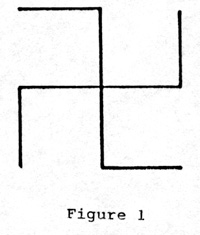
The first symbol to be explained is the Swastica, which Bart considers to be one of the oldest symbols in the world, and to contain encoded symbols representing the passage of the year. The Swastica (fig. 1) is composed of a number of directional elements, each of these in turn representing further connected concepts. North stands for night, cold, death and winter; East for sunrise, birth and rebirth, spring; South for day, warmth, life and summer; and finally West for sunset, the time of waning, old age and autumn. The centre position also has its relevant meanings and these five combine to make not only the swastica, but also the symbol, for the perpetual cycle of the day, the seasons and life itself. This can be represented as in fig. 2.
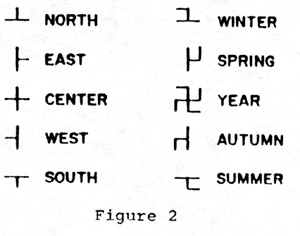
To these can be added a number of other analogues, including the use of colour and numbers to produce a table of the basic keys to this system of analysis.

Table 1 contains some of the most important concepts needed for any society, however supposedly primitive, to form a structured view of the world around them. While many of these correspondences still survive in fragmented form in the mythologies of various cultures, it is with the Native North Americans that the majority of this material can still be seen preserved in much of its original form, particularly in the Medicine Wheel.
This association of the colours of the rainbow with the celebrants of the seasons and numbers will be explained further in due course, as it is at the root of the subsequent examination of the labyrinth, but next it will be valuable to establish a number of important periods of time that would have been observed from the earliest times, and are fundamental to the understanding of early calendrical systems.
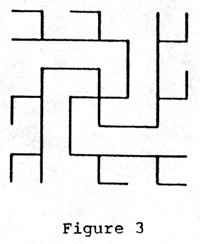
To return to the Swastica, an interesting representation on a Viking Age horse trapping (fig. 3) is not only a very elaborate version of the basic symbol but is also constructed of 36 lines, the number of ribs on a horse. This Bart claims is a shorthand representation of the 360 day horse--rib or base year. The Scythians who occupied Southern Russia during the Iron Age, and to whom the horse was very important both for mobility and trade, made elaborate sacrificial burials of horses, in some cases as many as 360 at a time, set in rounds of 18, in swastica pattern.
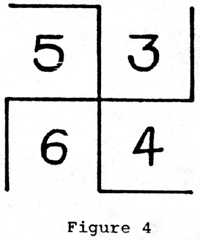
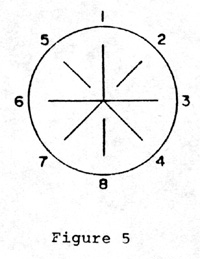
The correspondence between directions and numbers (see table 2), and their association with the swastica symbol can be summed up in the diagram opposite (fig. 4). The numbers contained within the swastica when multiplied thus: 3 x 4 x 5 x 6 = 360; again the base year. A further development on this principle is the placing of numbers around a circle in relation to the eight peripheral directions (fig. 5). The number 9, although not represented in the circle, is present by the process of addition of any two opposing numbers. The four nines resulting from this process add to give 36, the horse--rib number which we have seen is also representative of the base year. This symbol and process are in fact alluded to by Plutarch in the 'Morallia' where it is known as the `Tetractys'.

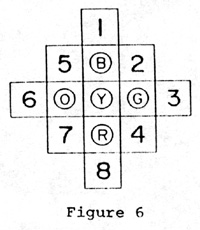
These same numbers superimposed upon a grid constructed of thirty-six lines, containing 13 squares (the number of lunar months in a year) produces a diagram as illustrated in figure 6. This figure is constructed from two separate grids overlaying each other. The first in the form of a cross (i.e. the squares containing 1, 3, 6 & 8, and all five colours) is composed of twenty--eight line-segments, representing the lunar--menstrual month. The other grid three squares square, while still containing twenty-eight lines and nine squares, is seen by Bart as the solar counterpart for the cross-shaped grid. The two figures combined create a lunar--solar grid that contains a number of codes for the reckoning of time. The five internal squares are filled with the rainbow colours red, orange, yellow, green and blue according to the principles outlined in table 1. The total reached by the addition of 1 through 8 is 36, representing the 360 base year; the five `coloured' squares form the five intercalary days needed to give the common calendar or solar year.
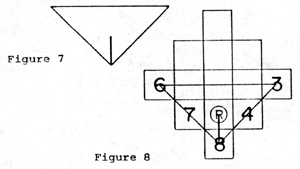
This diagram is at the centre of much of Bart Jordan,s work. From this basic numerical device, which he feels the ancients must have been familiar with, a number of ancient symbols can be analysed and seen in a new light. For instance, the Hittite pictograph standing for woman (fig. 7), which can be seen on carvings as far back as the Paeleolithic, when superimposed over the design cuts through the numbers 3, 4, 8, 7, 6 and the colour red (fig.8). The numbers involved add to 28, which with the added presence of the colour red is obviously indicative of the lunar menstrual cycle.
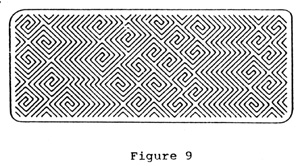
The meander pattern, familiar to many of you no doubt, which was looked at in some detail with regard to its topographical identity with the labyrinth in `Caerdroia 12' (it being possible to expand the meander directly into the labyrinth), also fits well into this scheme and takes on a whole new meaning. The meander is one of the most ancient symbols in the world; the examples carved on the Mezin bracelet (fig. 9, a reconstruction of the design from surviving fragments) have been dated to 20,000 bc for instance. It subsequently became very widely used, the early Neolithic examples from the Vinca Culture of the fifth and sixth millenia B.C. are excellent examples. It was used particularly by the Greeks, and was in many cases combined with the swastica in ceramic decoration of this period. The use of the repeating meander around the rims of bowls were seen to symbolize the wish of many good years to come.
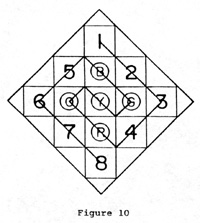
Applying the basic single-unit meander design over the lunar--solar grid described above and depicted in figure 6, the meander starts at the number 1 passing in clockwise motion through 2, 3, 4 and the colours Red and Orange, before turning about Yellow, the solar central point, to travel anticlockwise through Green, Blue, 5, 6, 7 and 8 (fig. 10). The meander not only follows the natural order of both the numbers and the rainbow colours, but passes through all thirteen lunar month squares, as well as all of the 365 days bound within the squares, to produce a symbolic process representing what Bart believes to be the world's oldest extant notation of the mechanics of the motions of a sun--centred Universe.
All of which brings us on to the Labyrinth itself, armed hopefully with an idea of how to approach the decipherment of a seemingly complex symbol such as it is.
Like the swastica and the meander, the labyrinth also contains a number of abbreviated calendrical counts, and is likewise the abode of the seasonal celebrants.
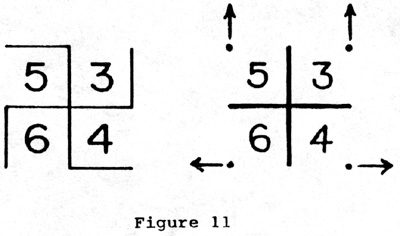
The construction of the design also bears a striking correspondence with the swastica depicted in figure 4, where the attributes of numbers, and therefore the seasons and directions, were superimposed. Using this symbol as a base it is possible to construct a labyrinth. The process is essentially similar to the `cross, arcs and dots' method of construction, with which many people will be familiar, but starts with only the cross and the dots. The numbers have particular relevance here, as they refer to the number of line segments drawn during movements in aparticular direction from the dots.

Beginning with the `three point' in the northeast quadrant, the wall line moves upwards and counterclockwise for three segments, then clockwise for nine, and then counterclockwise for six, finishing at the `six point' in the south east quadrant. Repeating the process from the `five point' in the north west quadrant, we begin with an upward and clockwise movement for five segments, followed by nine counterclockwise and then four moves clockwise to end on the `four point' in the south east quadrant (fig. 12).
This method of construction is in fact one of the most ancient and exacting methods known. It is possible to draw a complete labyrinth using both hands simultaneously without lifting pen from paper. Earlier in this century, an old man would sit by the Hollywood Stone in Dublin Museum and astound onlookers by being able to reproduce the labyrinth carved on this stone by this method. Obviously this was a talent passed down to him, and a good example that this method of labyrinth construction was still current, and possibly the numerical process with it, only 60 years ago, in Ireland at least.
A number of numerical functions are apparent here: the nine moves -- one clockwise, the other counterclockwise -- are the sums of the 3 & 6 and 5 & 4 movements that they connect. For each half of the construction the total number of movements is therefore 18; the two combined come to 36, the number of lines used in the building of the labyrinth, which we have seen is representative of the 360 day base or horse rib year. Equally, the important 3 & 6 and 5 & 4 moves when multiplied -- 3 x 4 x 5 x 6 = 360. The occurrence of the horse in this context is hardly surprising; how for instance was the city of Troy (connected in so many of the traditional names for labyrinths with this design) taken by the Greeks during their siege of the city? The Wooden Horse containing the Greek soldiers was left outside the city gates, through which it was too large to pass. The Walls of Troy were eventually breached by the Trojans themselves to allow through the Horse which was ultimately to be their downfall. The portion of the wall breached was on the western side -- "... beside the fig tree, where best the city may be scaled and the wall is assailable" (Iliad, VI, 434), the weakest section and the one prophesied to be the means by which Troy would fall.
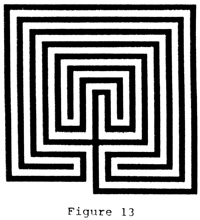
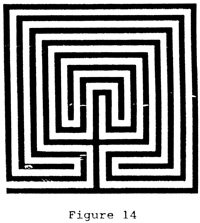
The labyrinth designwith which we are all familiar still has traces of this structural defect, for the design as shown in figure 13 is imbalanced on the lower left hand side, the consequence of which is that the left hand or west side of the Troy-Towns' walls are shorter than those on the right or east side. Squaring up the design by the addition of a line or wall drawn across from the conventional, entrance to guard this weak flank (fig. 14), or alternatively to represent the Wooden Horse standing before the gates awaiting entry to the City of Troy, would possibly help to understand the origin of this legend and the continuing connection between the labyrinth symbol, which although it is often taken to be a representation of the famous Labyrinth of Knossos where the Minotaur was held, is known throughout much of its range as Troy-Town, Troy's Walls or some similar allusion to this famed city.
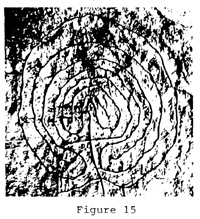
Although this configuration of the labyrinth with an extra line added may seem unfamiliar, or even unlikely, there is in fact a carving of a labyrinth from Luzzanas, Sardinia, where this extra line is included. The labyrinth (fig. 15), is 30 cm in width and is carved on a upright stone slab forming part of the south-west wall of the central chamber of a Neolithic chambered tomb (known locally as the "Tomba del Labirinto"). The carving is located next to the lozenge--shaped entrance of a further small chamber within the tomb. While it is not possible to date the carving accurately - it could have been carved long after the tomb was built - if it is contemporary, and many feel that it might be, then it could conceivably date to at least 2500 bc, and as such would be one of the earliest representations of a labyrinth in Europe, if not the world. It would also of course pre-date both the classical periods of Knossos and Troy which were supposedly its origin.
Another of the legends connected with the labyrinth worthy of further study here is that of Ariadne's thread. Ariadne was the daughter of King Minos, who had employed Daedalus and Icarus to construct the labyrinth to house the Minotaur. It was Ariadne's intervention in supplying Theseus with her ball of thread, or clew, that allowed him to traverse the passageways of the labyrinth, kill the Minotaur and retrace his steps without mishap, that put an end to the cruel tribute of seven maidens and seven youths who were sent from Athens every nine years to be fed, one by one, to the Minotaur.
It is curious that the unicursal labyrinth symbol should subsequently have been used to represent its legendary namesake, which clearly must have been multicursal and riddled with dead-ends and false pathways. If as would seem possible, the legend of Theseus and the Minotaur were grafted onto the labyrinth symbol long after its original development, then the role of the thread in the story becomes rather tangled. While Ariadne's thread may have been of considerable help to Theseus to find the Minotaur and retrace the path out to safety, the use of the clew in a labyrinth with only one pathway is clearly pointless. However, when the labyrinth is constructed with breaks in the paths where the direction of travel changes (fig. 16), as explained above in connection with fig. 12, the need for the clew in the understanding of the labyrinth's true path becomes apparent. Knowledge of the true path through the labyrinth is in many ways as important as knowing the arrangement of the walls enclosing the pathway.
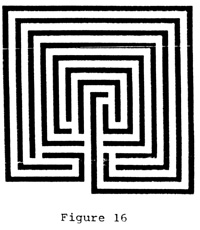
This path, as travelled by Theseus with the clew firmly clasped, forms an interesting pattern. With the circuit of the labyrinth numbered from 8 on the outermost passage to 2 for the innermost, and 1 being the abode of the Minotaur, the central goal, Theseus first passes through passages 6 and 7. From there the sequence runs through 8, 5 and 2 as he moves rapidly from the outside almost to the centre, only to find himself then treading passages 3 and 4 before entering the central enclosure where he meets and kills the Minotaur. The sequence of 8, 5 and 2 -- the central portion of the progress through the labyrinth when multiplied produce 80. The other four moves -- 6 and 7, 3 and 4 when multiplied produces 504. The total of these moves is 584, the average synodic revolution of the planet Venus. Ariadne is often seen as the earthly personification of Aphrodite, known to the Romans as Venus. Ariadne is indeed the mistress of the labyrinth, and her clew, the thread that guides safely through the labyrinth, indeed holds the key!
The ideas in this article are but a small selection from the work that Bart Jordan has produced in his attempts to decipher some of the world's most ancient symbols.
[1] See NEARA Journal. Vol. XIX, No. 1 4. & Now Hampshire Times, Jan. 12, 1977 lpp. 1619), Jan. 19. 1977 lpp. 13-15).
[2] A synodic year is the time interval between successive op' positions of the Earth and the planet in question.
[3] The 360-day Base Year is common to many ancient calendar systems, extra intercalary days being added as appropriate to this base unit.
[4] The time taken for the Earth's axis to prescribe a complete rotation as it "wobbles." It is this motion that causes the pole star to change, etc.
Editor's Note: Although the text for this article is (c) Caerdroia. the illustrations are (c) Bart Jordan, except Figure 15.